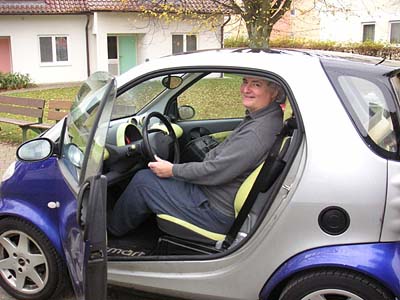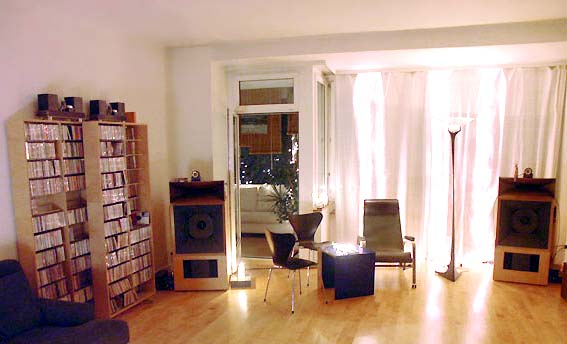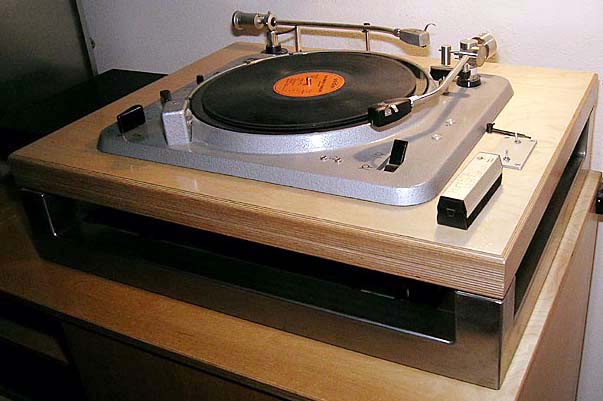
(Photo credit by Franz Gysi)
Welcome to my little photo-journal of my recent trip to Zurich, Munich, and the ETF.04. Yes, that's me in a Smartcar, which like Dr. Who's TARDIS, is actually bigger on the inside than it is on the outside. How those clever Swiss and Germans accomplish that is a great mystery.
Before going further, I want to give a great big Thank You to Christian Rintelen, the tireless festival organizer, gracious host, tour guide, minivan driver, freight handler, and gatherer of lost sheep. I'm still amazed that none of the American contingent aren't still wandering around aimlessly in a Swiss or German countryside town - talk about herding cats! We all made it back in one piece, with wonderful memories and photos.

The Hotel St. George, where our intrepid little band of American triode nuts stayed in Zurich. My room was one story above the Swiss flag (on what Americans call the third floor) - see it?
The St. George is a charming traditional Swiss family-run hotel, reasonably priced in an expensive city, and centrally located - we were only a few hundred metres from Christian's apartment, close to lots of gourmet-quality restaurants, and about 1 km from the main train station and downtown Zurich.

Here's the pleasant view out the window, looking out on the square outside the hotel (where the first photo was taken). The green diagonal on the right side of the picture are Christmas lights for the hotel.

The square (OK, it's a triangle) outside the hotel. Gary Pimm (in the red jacket) and John Atwood are returning from stroll at dawn in downtown Zurich. All the pictures, by the way, have a fair amount of Photoshop color-correction to get rid of the blue cast from the heavy overcast skies of central Europe in early December. No snow - although it was certainly cold enough, just above freezing - but some days there was a light mist, similar to winter days in the Pacific Northwest.

(Photo credit by Christian Rintelen)
As the day turned to evening, our little band of Americans (Steve Bench, John Atwood, Gary Pimm, Gary Dahl, and myself) walked the two blocks from the hotel to Christian Rintelen's apartment, and were treated to his Blue Thunder horns, custom all-triode electronics, and an EMT 930 turntable with FR64 and Ortofon tonearms, Ortofon SPU spherical-stylus cartridges, and Christian's stunning Baltic-Birch over stainless-steel base.
Yes, it was a treat, jet lag and all. I'm not normally a horn fan, but Christian's Blue Thunders deliver the goods, and were astonishingly sweet and musical - combined with a first-row-center sense of presence and liveliness. This is not a dull system or audiophile-correct system - this one plays music, first, last, and always. Just out of sight, beyond the right side of the picture, is Christian's massive 2000+ record collection, filling the entire wall between the right speaker and the EMT 930 phonograph (shown below).
Christian had great fun playing the DJ, playing one record after another, including his now-legendary collection of different versions of "Fever" - did you know there were more than 260 versions of this one song!? No joke, and some real classics there, too, which we got to hear.
Imagine a private radio station with the best damn PA you ever heard, and that's what that evening was like. A groove, man. We all had a great time, drinking great beer and wine, staying up till late that night, and a fantastic welcome to Europe and the ETF.

(Photo credit by Christian Rintelen)
Going back to equipment, the EMT 930 deserves star billing on its own - compared to audiophile turntables, it plays music with an unstoppable sense of rhythm that just jumps out at you. It makes audiophile claims of PRaT (pace, rhythm, and timing) nothing short of laughable - this is the real thing, a broadcast turntable built like a cutting lathe, and frankly, it sounds like it. Only the frightening market price of good-condition EMT 930's - 4000 Euros! - damped my desire for a 930 turntable.
In Europe, EMT turntables were widely used in radio broadcast, in the same way more mundane Rek-O-Kuts and QRK turntables were used in American radio stations. During the mid-Eighties, even the legendary EMT 930 (as seen above) was easy to find when stations switched over to digital sources, but when the MJ crowd discovered them a few years later, prices ascended to Akihibara levels, even in Europe.
Sonically, the hype is justified - the 930 does things modern turntable don't, and has the unstoppable pace and drive of a locomotive. Astonishing build quality - German over-the-top engineering at its finest, makes everything else (including the Garrard 301 and Thorens TD124) look like a toy. Like all broadcast turntables, these things have torque, reaching full and precise speed in less than a quarter-revolution.
Tech Note: If you've ever been in a traditional radio station with turntables - and I probably date myself here - you've seen a pair of heavy-duty, high-torque turntables in a gray steel console that weighs several hundred pounds. DJs can be clumsy in their hyperactive way, and the console has to be heavy enough to withstand a DJ colliding full-force against it without the phonograph jarring or skipping a groove. As a result, broadcast turntables, even as far back as the 1930s, were always mounted in consoles weighing hundreds of pounds.
When audiophiles listen to turntables that were actually used for AM and FM radio broadcasts - Garrard 301 and 401, Thorens TD 124, various models of EMT, various Technics models - they were all intended for mounting in far heavier consoles than typical lightweight domestic TT bases. The re-discovery of what appear to be massive TT bases is nothing more than using these turntables as they were originally meant to be used. And - surprise, surprise - they sound really good, just as they did back in the days of quality FM broadcasting.
Text and Pictures © Lynn Olson 2005, except where noted.